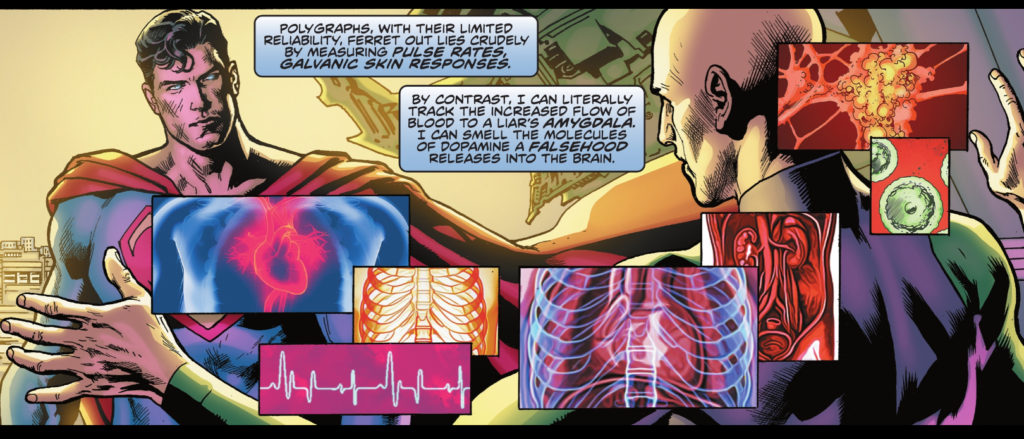Sure, Daredevil can tell when people are lying by listening to their heartbeats speed up. But that’s Daredevil.
But Superman can do this too. As shown in stories by Joshua Williamson, Tom Taylor, and many others, Superman always listens to Lois and Jon’s voices and heartbeats. In the latest Action Comics storyline, Superman is “tuned in” to Luthor’s voice, who’s talking to him from a jail cell.
In Superman: The Last Days of Lex Luthor #1 by Mark Waid, Bryan Hitch, and Kevin Nowlan, we see how far Superman’s powers can go in this direction.
In the story (outside of regular continuity), Luthor, poisoned by Kryptonite radiation, is dying. He attracts Superman’s attention in a very Luthor fashion and tells him he only has a few days to live. Gambling that the hero will try to save him once he knows that he’s dying, Superman will do whatever he can to save him.
And he’s right.
But – Superman wants to verify that Luthor’s not lying, which brings us to the one panel with a lot of science:
Let’s break it down.
Poygraphs(*) — “poly” (many, in this case, six) and “graph” (the strip of moving paper that the six sensors write on) are lie detectors. They’re a fixture in crime dramas.
As Superman says, they’re about pulse rates and galvanic skin responses but also look at blood pressure, respiratory rate, and galvanic skin responses, which measure the skin’s electrical conductance. The salty water of sweat causes an increase in conductance, but so does the skin in a heightened state of emotional arousal. Yes, that, but lying as well.
Needles skritch out these responses on the chart paper as it unspools. In theory (results are subjective and are generally not allowed as evidence in court), a heightened emotional state causes changes in what the polygraph measures.
The rest of Superman’s commentary — that he can track the increased flow of blood to a liar’s amygdala and small the dopamine in their brain when they lie — that’s because lying has neurological effects.
When you lie, you’re asking your brain to pull out of the reality it knows and install itself in this new reality you’re creating. That’s tough work for the brain. It will need more blood flowing to parts crafting this new reality, while regions not playing a role get less attention and might not work as well as they would if you told the truth.
Lying is stressful for the rest of your body, too. Your adrenal glands kick in, releasing epinephrine — “fight or flight.” Epinephrine increases your heart and respiratory rate and bumps your blood pressure up.
But Superman calls out two things he’s checking in Luthor’s brain:
Amygdala(**) activity. The amygdala is a piece of the brain that plays a role in processing emotions that’s also crucial in laying down memories, learning, and deciphering information from your senses. Research shows that when people lie, the amygdala “lights up” or shows more activity, as seen during a brain scan. The brain’s emotional center knows something’s up and acts to put guardrails up. That icky negative feeling you get when you tell a small lie? Your amygdala recommends this isn’t a road you want to travel all that often.
But here’s where our science and the Superman-Luthor scene diverge. Research published in Nature Neuroscience in 2016 suggests the amygdala’s response isn’t constant. It declines with lie frequency and size. Tell lots of lies, and your amygdala throws up its metaphysical hands and taps out.
Here’s the thing — Luthor has told a lot of lies, like a lot. Along with trying to kill Superman, it’s what he does. If research on our earth carries to the DC Universe, Luthor’s amygdala would barely flicker if he were lying about dying. He’s that good at it.
Smelling dopamine. Dopamine is a neurotransmitter associated with the “reward” centers of the brain or feeling of pleasure. It’s also involved with motion, memory, mood, attention, etc.
When a person lies, the brain releases a squirt of dopamine. It was a thrill, this bending of reality. Dopamine is one of the fuels of addiction — the brain’s reward for doing something it likes, whether good or bad for the body. Hit social media and see a like on your post? Dopamine squirt. Drink with friends? Dopamine squirt. Tell a lie? Dopamine squirt.
But neurons get used to their squirt of dopamine over time, and it takes more of the pleasurable stimulus to get the same effect from a dopamine squirt. That’s the foundation of addiction — the brain needs more stimulus for the same response, so go get more.
And as for Superman smelling dopamine? Completely plausible. We can’t, but dogs with olfactory receptors that are 10,000 – 100,000 times more sensitive than ours can smell hormones related to stress, “odors” from cancer cells, and more. Superman smelling dopamine is not a far reach, but it also opens the door to the world being a smell-filled place for him.
But when we bring this back to the DCU, we encounter the same problem as we did with the amygdala. Luthor lives to lie, so the days of him getting a squirt for something like, “I’m dying,” are most likely long gone. I’d imagine the size of the lie Luthor would have to tell to get a dopamine hit would be gigantic, like, “I’m your father.”
All told Superman’s super-sniffy and super-squinty approach to lying would’ve worked on a six-year-old telling him they had an elephant sandwich for lunch, but for a pathological liar like Luthor? That’s a tough sell. From the signs Superman can measure, Luthor lying would look like Luthor telling the truth. The science is good, but the subject could easily get around it.
A quick cheat from the “Single Panel” idea, Superman says (in the next panel) he’s memorized Luthor’s pulse rate and the neural patterns of his prefrontal cortex.
Not sure how he “sees” Luthor’s brain patterns, but that would track — the prefrontal cortex is the covering of the front lobe of the frontal cortex of our brains. It’s what we use for thoughts, actions, and emotions. It’s where the skills we associate with “executive functions” happen. It’s also an area of intense study related to free will — whether or not we have it. According to research, “ideas” form in the prefrontal cortex up to 10 seconds before they enter our brain as something we’re “aware” of.
Let that sink in for a minute. Did an eyebrow go up? Two? Yeah, Batman smiled as well.
If Superman knows Luthor’s prefrontal cortex patterns, he could — hypothetically — “read” Luthor’s mind and be able to counter anything Luthor does before Luthor does it. Or before Luthor was even aware that he was going to do it. Free will and neurology is some weird stuff.
Again, this is the DC Universe, and he is Superman. Still, if someone were capturing and documenting the patterns of people’s pre-frontal cortexes in our world, we wouldn’t call them superheroes. And we’d call our world a dystopia.
Superman: The Last Days of Lex Luthor is a fun story — and there will be plot twists and turns coming up that may take this all in mind, but for now, let’s keep DC Universe science over in the DC Universe.
(*) – Fun fact about the polygraph – its creator was William Moulton Marston, a psychologist who also created Wonder Woman. There’s a training academy that still bears his name. He was an interesting person, and the biographical film about him, Professor Marston and the Wonder Women is worth a watch whenever you can catch it, maybe just not with your parents.
(**) – Fun fact about the amygdala. Batman has a villain named Amygdala, originally a child suffering from violent emotional outbursts. To treat him, doctors removed his amygdala. He grew enormous and is still violent. But now, Batman punches him a lot. Also – spelling amygdala is easy if you think of it as a name, “Amy G’dala.” You’ll never spell it wrong. Don’t say it that way; it’s pronounced “ah-mig-dala.” Say it out loud the name way, and the needle gets pulled off the record, no matter what room you’re in.










